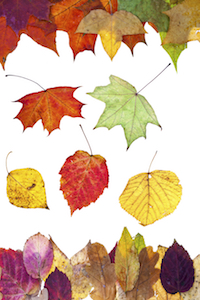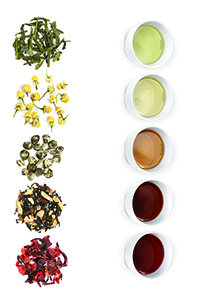The Art & Craft of Processing Tea Leaves


WITHERING
From the moment the tea leaves are plucked, they begin to wither and to lose their moisture content. A controlled wither further reduces the moisture content by one-half to one-third (or variables). This is achieved by spreading the leaves on screened tables where either the air alone or heated air further withers the leaves to the desired percentage. The leaves are continuously rotated (by hand or machine) to achieve an evenly withered leaf. The natural chlorophyll begins to fade, the aroma and flavor is accentuated, and polyphenol activity is initiated through oxidation. In Chinese, this is called sha qing (or shaqing), which translates to inactivating the enzyme.
ROLLING AND SHAPING
Once withered, the leaves are ready to be rolled and shaped.
The orthodox method of rolling (by hand or machine) is common practice in India and Sri Lanka. It causes some of the natural essential oils to seep out and elevate the taste of the tea. These two countries also use the CTC method (cut, tear, curl) to chop the tea leaves into tiny pieces that are then rolled by machines into tiny pellets, which are primarily found in tea bags of blended and unblended teas.
For Japanese and Chinese teas, however, shaping means to manipulate the tea leaves into a noticeable form.
Neither hand rolling or machine rolling impacts the flavor as much as the careful eyes and experienced hands of those who guard the leaves over the screened , they are withered and dried or manage the roasters or fire-heated woks which further wither the leaves to certain percentages. For many processors, it is their ears which listen for the sounds that the roasting is complete. Or some rely on their noses which can detect just that moment when the drying is complete, like a perfumer's nose can detect the right oils to add to their scents.
Tea leaves can be heated to stop the oxidation (release of moisture.). In China. tea masters use a stone wok that is heated over fire. The masters move the leaves around the hot wok for even firing prior to shaping the leaves. The leaves are then , shaped into strands, or crushed. The rolled technique extracts the moisture at a slower rate; the strands are softer and of higher quality, however, the crushing is done for lower-quality teas, and these days, often by machine. The stranding and rolling applies primarily to greens. Whites are never processed further than air drying/withering, so that the leaf buds stay intact.
CLASSIC SHAPES
Some shapes, like balls, are classic and have rarely changed, except to make them smaller or larger. Others continue to evolve, like showplace teas, where the most creative hands can tie leaf to leaf, to create shapes akin to fruits and flowers and other references to nature. What follows are the most popular shapes.
GUNPOWDER
Originally hand-rolled into small round pellets, gunpowder got its name from its resemblance to grains of gunpowder the British brought to China. Today, most are machine rolled and grades may number up to 11, including: pinhead, pea, balls or, as it was in the 18th century, pellets. Gunpowder is sometimes sold under its Chinese name, zhū cha.
Our gunpowder tea offers a hint of smokiness to a smooth cup.
PEARLS
Also known as tea balls, these are sometimes referred to the oyster's jewel size, with 6mm being the average. They may be rolled around a small piece of thread to help shape it firmly, or use only leaves and careful handling. Greens, whites, and blacks are shaped into balls; however, the most popular one in the world remains the Jasmine-infused pearl. The finest of these include the leaf bud and one (or maybe the two) top tea leaves. These are mixed with fresh Jasmine, often up to seven times to ensure the flower's scent is imbued in the tea leaves, which are then hand-rolled into the pearl shapes. To steep the finest examples requires only one to three pearls steeping for a deeply rich cup. Re-steeping proffers up to four steepings. When the pearls are steeped, the elegant leaves unfurl and the scent is intoxicating and the taste is silky. Adagio;s black pearls offer a satisfying smooth cup, and the greens, a delicate tea perfect for the afternoon. For the ultimate tea experience, Jasmine tea is superb.
SPIDERLEG
This is a designation given to long, twisted tea leaves, like sencha. The green leaves are steamed to reduce oxidation, rolled to activate the enzymes, then graded. The needle-shaped leaves have a deep, grassy flavor with an edge of sweetness. Generally machine rolled, although some of the smallest farm processors still hand roll, these leaves open up gracefully when brewed showing off their full-leaf beauty.
SHOWPLACE (Mudan)
These are a hostess' delight and terrific icebreaker for conversation. Set one into a red wine goblet, pour on some hot water, and place the glass in back of each guest's plate. The mudan(the Chinese word for showplace tea)-will unfold or "blossom" while dinner is enjoyed; then they're ready to be drunk with dessert. The shaping is a laborious technique of hand-tying tea leaves together and, in the finest examples, only leaves are used; in lower-priced examples, thread may be used to keep the leaves firmly together. Hummingbird's nests, peony flowers, strawberries, and other similar items of nature are common designs. The teas benefit from the lower water temperature and long brewing time and the white or green teas offer a mild taste, a perfect introduction for the newbie to specialty tea.
EYEBROWS (Mei Cha)
This Chinese tea has two distinct looks: the finely formed Precious Eyebrows (Chunmee) and the more crude Longevity Eyebrows (Shou Mei.) Both are barely the size of the edge of a fingernail. The top grade, Chunmee, is hand rolled and pan-fired. Green and white tea versions are available in every Chinese province, although the finest are said to be from Fujian and offer a refreshing light taste, excellent as an after-dinner beverage. Our Chunmee-inspired tea offers a light, yet smoky aroma and is an ideal cup to enjoy in the evening.
NOTE: In older reference books on tea, Chunmee (Shou Mei) was called Hyson, a version of the Chinese term for when it was plucked, Yu Tsien (Before the Rains.) A former director of the East India Company, Philip Hyson, may also be the source of this word—perhaps an early attempt at branding and marketing.
